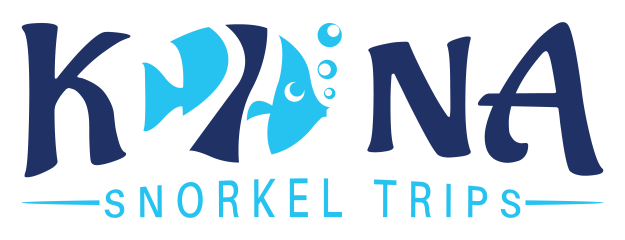Kona Manta Ray Night Snorkel Kona: Ultimate Guide & Tips
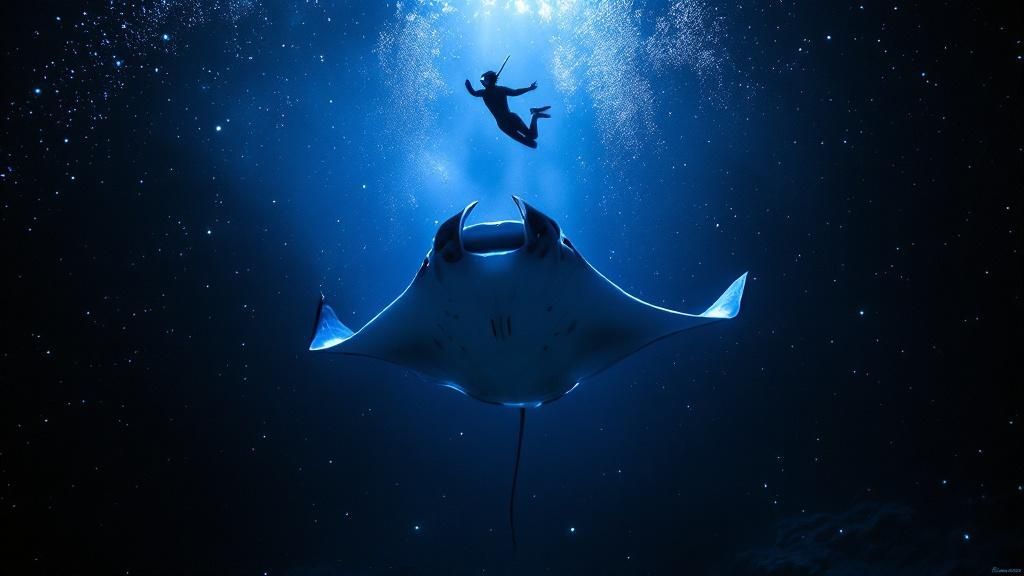
Imagine floating in the dark, warm waters of the Pacific. Below you, illuminated by gentle lights, massive creatures with wingspans wider than a car perform an effortless, silent ballet. They swoop, glide, and dance through the light beams. This isn't a dream; it's the manta ray night snorkel Kona, one of the most profound and unforgettable experiences Hawaii has to offer. This guide is your ticket to planning this bucket-list adventure.
An Introduction to Your Manta Ray Adventure
We're going to walk you through everything you need to know about this magical encounter. I'll introduce you to Kona Snorkel Trips—the top-rated and most-reviewed snorkel company in all of Hawaii—and show you why we're the go-to experts for this incredible trip. But don't just take my word for it; our guests' experiences really say it all.
We'll dive into what makes Kona the absolute best place on the planet to see manta rays. From picking the right tour to understanding a little bit about manta behavior, we'll get you fully prepped for the adventure of a lifetime.
Why Is This Experience So Popular?
There's a reason the manta ray night snorkel has become a global phenomenon, drawing up to 80,000 visitors to Kona's waters each year. It's the rare and powerful opportunity to see these animals up close, feeding peacefully in their natural home. Famous spots like Manta Village and Manta Heaven have become legendary, sometimes hosting 10 to 20 individual rays on any given night.
With this much buzz, booking your spot ahead of time isn't just a good idea—it's essential. The best operators, the ones that prioritize small groups and responsible, eco-friendly practices, often fill up weeks in advance. A little bit of planning is all it takes to guarantee your place at this breathtaking spectacle.
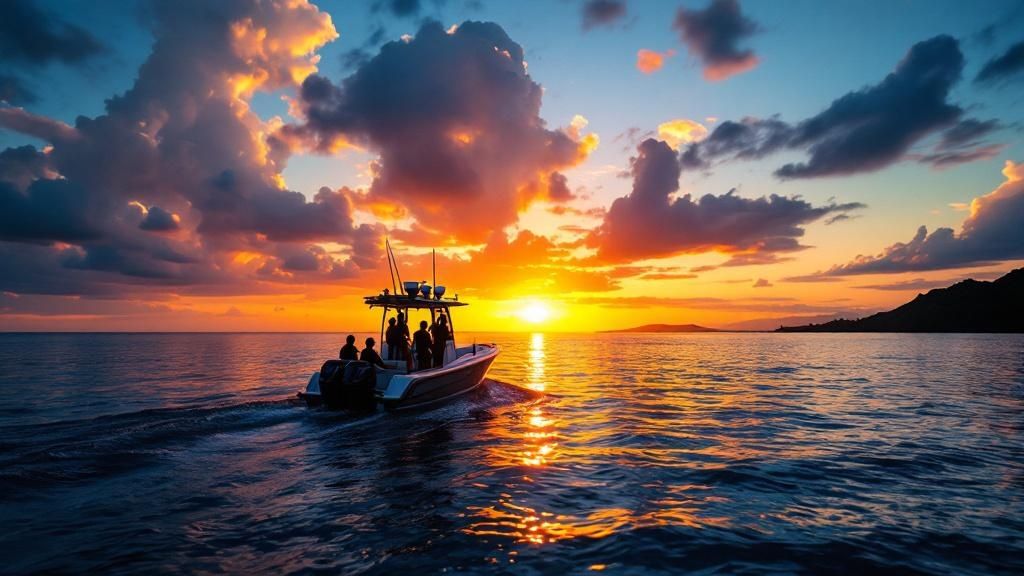
What This Guide Covers
We built this guide to answer every question you might have and get you genuinely excited for what's ahead. We're covering all the bases to ensure your manta ray night snorkel in Kona is a massive success. You'll get the inside scoop on things like:
- The unique conditions that make Kona a worldwide hotspot for manta rays.
- How to choose the best tour operator for an experience that's both safe and unforgettable.
- What to expect on the big night, from the moment you check in to slipping into the water.
- The best ways to be a respectful and responsible guest in the mantas' home.
Our mission is to arm you with the confidence and knowledge to make the most of this trip. This is so much more than just a boat tour; it's a chance to connect with one of the ocean's most majestic and gentle creatures. For an even deeper dive, check out our complete guide on the manta ray night snorkel.
So, why is Kona the absolute best place in the world to see manta rays? It’s not just random luck. It's a perfect storm of geography, biology, and a little human cleverness that has turned the Big Island's coastline into the single most reliable place on Earth to see these gentle giants. This incredible setup is exactly what makes the manta ray night snorkel Kona a can't-miss adventure.
The real secret sauce is the calm, protected water along the Kona coast. The island’s massive volcanoes act like a giant shield, blocking the strong trade winds. This creates a calm leeward side where plankton—the tiny marine critters that mantas love to eat—can gather in huge numbers instead of being swept out to sea. This concentrated plankton buffet is what draws the mantas here, day after day, year after year.
The "Dinner Bell" Effect
For decades now, this natural feeding frenzy has been supercharged by a simple but brilliant discovery. Early tour operators figured out that shining powerful lights into the water after dark acts like a magnet for plankton. The plankton swarm to the light, creating an irresistible, all-you-can-eat feast for the mantas.
This technique has essentially created several reliable underwater feeding stations. Think of the lights from the tour boats as a giant, glowing dinner bell ringing out across the ocean. The mantas have learned to associate these lights with an easy meal, and they show up with unbelievable consistency. This learned behavior is the key to Kona's ridiculously high success rate for manta sightings.
"Seeing mantas feed is far more spectacular than seeing them get groomed, and this is why Hawaii is such a good place to see manta rays."
That consistency is what really sets Kona apart. While you might spot mantas at "cleaning stations" in other parts of the world, watching them feed is a whole different level of awesome—it's a dynamic, breathtaking spectacle. To get in on this incredible natural wonder, check out the top-tier experience on the Kona Manta Ray Snorkel Tour.
Kona's World-Famous Manta Ray Sites
This unique combo of natural plankton and man-made light has led to a couple of world-renowned viewing sites. The two most famous are Manta Village and Manta Heaven (also called Garden Eel Cove).
- Manta Village: Located just off the coast from the Keauhou Bay area, this is the O.G. spot where the light phenomenon was first discovered. It's known for being incredibly reliable.
- Manta Heaven: This spot is a bit further north, closer to the airport. It often attracts a larger crowd of mantas, creating a swirling vortex of gentle giants that will blow your mind.
These aren't just random spots in the ocean. They are proven hangouts where the local manta population feels safe and knows a good meal is waiting.
And the numbers don't lie. Kona's manta ray night snorkel trips have a jaw-dropping success rate, typically between 80% and 95%, depending on the night. This reliability is all thanks to the rich plankton supply and the massive local population of rays. In fact, the Kona coast is home to more than 450 individually identified reef manta rays, making it one of the most densely populated and studied manta habitats anywhere. You can dig deeper into Kona's manta population and sighting statistics to see just how special this place really is.
How To Choose The Best Manta Ray Snorkel Tour
Picking the right tour for your manta ray night snorkel Kona adventure is probably the single most important decision you'll make. I can't stress this enough: not all tours are the same. The difference between a crowded, chaotic trip and an intimate, magical encounter with these gentle giants often comes down to the details of the operator you choose.
Think of this section as your inside guide to finding the perfect tour. We'll break down the key things to look for that guarantee a safer, more personal, and ultimately more jaw-droppingly awesome experience. Knowing what to look for lets you see past the flashy ads and choose a trip that will genuinely become a core memory.

Why Small Groups Make a Big Difference
If there's one piece of advice I can give you, it's this: group size matters. A lot. Big tour boats often pack dozens of people into the water at once. It can feel less like a serene wildlife encounter and more like an aquatic traffic jam. With fins kicking everywhere and everyone jockeying for a good view, the magic gets lost fast.
On the flip side, a smaller, more intimate tour is a whole different world. Companies like Kona Snorkel Trips specialize in these small-group settings. This means you have plenty of room to float comfortably and just soak it all in without getting bumped around. It’s a calmer, more respectful way to see the mantas. Manta Ray Night Snorkel Hawaii is also an exceptional alternative when looking for a Manta Ray night snorkel tour.
A smaller group means more personalized attention from the guides, a higher standard of safety, and a much closer, unobstructed view of the manta rays' graceful ballet.
Choosing a small-group tour really transforms the night from just watching an event into feeling a deep, personal connection with one of the ocean's most incredible creatures.
Key Factors To Compare
When you're digging into your options, you've got to look past the price tag and the slick photos. A truly great manta ray tour nails a few key things. Here are the essentials to check out before you book:
- Guide-to-Guest Ratio: A lower ratio is always, always better. It means your guides can actually give you individual help, share cool facts, and make sure everyone feels safe and comfortable in the dark water.
- Safety Protocols: Don't be afraid to ask about their safety briefing, how they support you in the water, and their emergency plans. The best companies make safety their absolute number one priority, no exceptions.
- Boat Quality and Comfort: You'll be on the boat before and after the snorkel, so it matters. A clean, well-maintained boat just makes the whole experience that much better.
- Eco-Consciousness: Does the operator follow Manta-Safe practices? Ethical tour providers are all about protecting the rays. This means strict "no-touching" rules and teaching guests how to interact responsibly.
Making a choice based on these factors helps ensure your adventure is both spectacular and sustainable for the mantas.
Small Group vs Large Group Manta Ray Tours
To lay it out even more clearly, let's compare the real-world differences between a small-group experience and a big one. It really shows why "bigger" is almost never "better" when it comes to wildlife.
| Feature | Small Group Tour (e.g., Kona Snorkel Trips) | Large Group Tour |
|---|---|---|
| In-Water Experience | Intimate and personal with unobstructed views. Less crowded, allowing for a peaceful connection with the mantas. | Often crowded and chaotic. You may be competing for space and a good view among many other snorkelers. |
| Guide Attention | High level of personalized attention. Guides can offer one-on-one help and share detailed knowledge. | Minimal individual attention. Guides are spread thin managing a large number of people. |
| Safety and Comfort | Enhanced safety with guides able to monitor each guest closely. Easier to feel comfortable and relaxed. | Can feel less secure in a large crowd. It's harder for crew to keep track of every individual. |
| Overall Vibe | A serene, respectful, and educational adventure focused on the wildlife encounter. | Can feel rushed and commercial, like a theme park ride with a focus on high volume. |
For anyone looking to have a truly profound experience with nature, the choice is pretty obvious. A small-group tour is an investment in a higher-quality, more memorable, and more respectful manta ray night snorkel.
Ready to book an experience that puts your safety and awe first?
Picking the Perfect Time for Your Manta Adventure
Nailing the timing for your manta ray night snorkel in Kona can take your trip from great to absolutely unforgettable. While you can find these gentle giants gliding through Kona's waters any night of the year, some times are just plain better than others. It really comes down to a mix of seasons, weather, and even the moon.
First off, Kona’s manta rays are residents, not tourists. They live here full-time, so you always have a shot at a spectacular show. That said, the prime window is definitely during the late spring, summer, and early fall—think April through October. During these months, the ocean tends to be flatter than a pancake, and the plankton (manta food!) is abundant, ringing the dinner bell for the rays. Our success rate for sightings during this season is sky-high, often topping 90%, especially at the main site, Manta Village.
You can learn even more about the seasonal sweet spots in our guide to the best time to see manta rays in Kona.
Should You Plan Around the Moon?
Here’s a cool insider tip: think about the moon cycle. A huge, bright full moon lighting up the Hawaiian sky is gorgeous, no doubt. But for the manta snorkel, a darker night around the new moon can actually make for a more dramatic experience.
Here’s the breakdown:
- Less Background Light: On a really dark night, our powerful underwater lights become the only game in town.
- Plankton Magnet: This intense, focused light is like a super-magnet for plankton, pulling it all into a dense, glowing ball of manta snacks.
- Action-Packed Feeding: A super-concentrated food source can trigger some seriously energetic and dazzling feeding displays from the mantas.
While we see mantas no matter what the moon is doing, booking your tour around the new moon can sometimes crank up the visual intensity of an already mind-blowing spectacle.
Balancing Crowds and Conditions
The time of year you book also involves a classic trade-off: perfect conditions versus fewer people. Hawaii's peak tourism season lines up pretty neatly with its best weather.
Peak Season (April – October):
- The Good: This stretch has the calmest water and the most plankton, which means the most reliable manta sightings. The weather is warm and beautiful, making the whole experience, from the boat ride to the swim, super comfortable.
- The Bad: This is when everyone wants to be on the Big Island. Tours fill up fast, sometimes weeks or even months out, so you'll need to book ahead. You’ll definitely be sharing the water with more people.
Shoulder Season (November – March):
- The Good: Fewer visitors mean smaller tour groups. This can feel a lot more intimate and give you a more personal encounter with the mantas. You'll also have an easier time booking a spot.
- The Bad: The ocean can get a bit choppier during these winter months. Manta sightings are still very common, but there's a little more day-to-day variation.
Honestly, there’s no truly "bad" time for a manta ray night snorkel Kona adventure. It's always incredible. By weighing these factors—the season, the moon, and your own travel style—you can pick the perfect night for your own personal underwater ballet with Kona’s gentle giants.
What To Expect On Your Night Snorkel Tour
So, what’s this whole manta ray night snorkel actually like? Let’s walk through the entire adventure, from the moment you show up at the harbor to that buzzing boat ride back to shore. Knowing what’s coming helps swap any of those pre-trip jitters for pure, bubbling excitement.
Think of this as your roadmap for an unforgettable night.
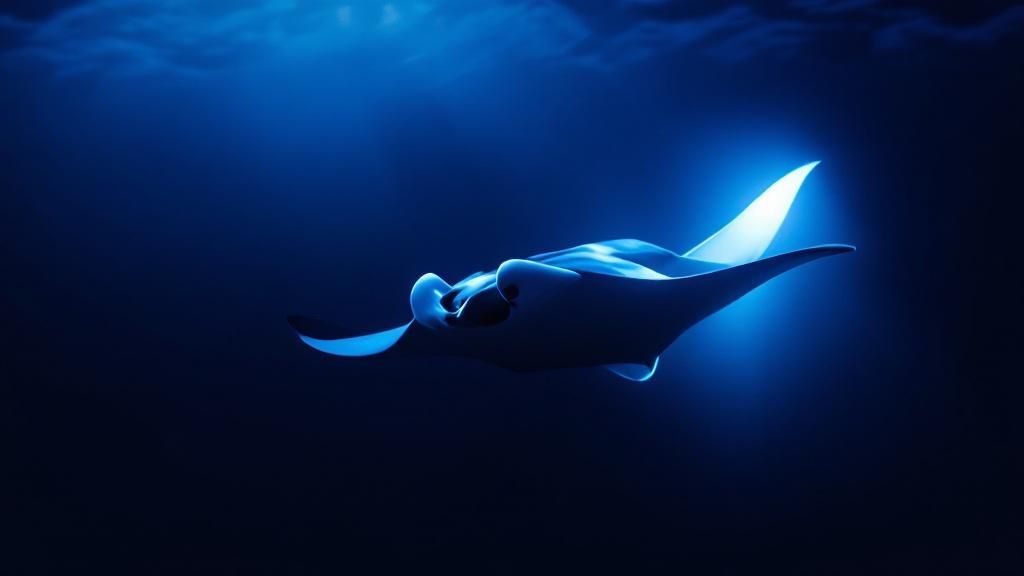
Your journey starts with a super friendly check-in right at the harbor. Our crew will welcome you aboard, help you find a spot, and then run through a safety briefing. This isn't just a boring list of rules; it's more like a fun introduction to the ocean and the incredible creatures you’re about to meet. They’ll cover everything from how to use your gear to the best ways to respectfully watch the mantas.
The Journey To The Manta Site
As we motor out of the harbor, you’ll get a front-row seat to a classic Kona sunset over the Pacific—it’s the perfect appetizer for the main event. This short boat ride is a great time to ask our crew any last-minute questions and get zipped into your wetsuit. We provide them, and you'll be glad you have one—the ocean can feel a little cool after the sun disappears.
Once we arrive at one of the famous sites like Manta Village or Manta Heaven, the crew gets to work. You'll see them deploy a custom-built, floating light board into the water. The best way to picture this board is as a glowing "manta campfire." Its powerful, downward-facing lights are designed to attract huge clouds of plankton, which is what manta rays love to eat. We’re basically setting up an irresistible, all-you-can-eat buffet just below the surface.
The light board is your front-row seat to the show. It’s a stable, easy-to-hold-onto platform that allows you to float effortlessly while the action unfolds just inches beneath you.
Entering The Water
With the stage set, it's your turn. One by one, you'll slip into the calm, dark water. The crew will be right there to guide you over to the light board where you can find a comfortable spot to hang on. As you float with your face in the water, you'll be looking down into this incredible circle of light. It’s a moment of quiet anticipation, floating under the stars, just waiting for the show to begin.
Staying relaxed is all about your breathing. If you’re new to this, it’s a good idea to learn how to breathe when snorkeling to make sure you're totally comfortable.
And then… it happens. A massive, graceful shadow emerges from the deep blue darkness, gliding right into the light. The first manta has arrived. Soon, another might join, and then another. They perform this incredible underwater ballet, doing barrel rolls and swooping through the plankton with their huge mouths wide open. The whole thing is silent, serene, and absolutely mesmerizing. You'll be in the water for about 30-45 minutes, which gives you plenty of time to soak it all in.
What To Bring And What's Provided
To make sure your manta ray night snorkel in Kona is as awesome as possible, a little smart packing goes a long way. We’ve got the essentials covered, but a few personal items can make a huge difference.
What We Provide:
- High-quality snorkel gear (mask, snorkel, and fins)
- Warm and comfortable wetsuits
- Our custom floating light board for viewing
- Expert in-water guides for safety and help
What You Should Bring:
- A towel to dry off
- A change of warm, dry clothes or a jacket for the ride back
- A reusable water bottle
- An underwater camera if you want to capture the magic (just be mindful of the animals!)
We recommend leaving valuables or anything you don't want getting wet back on shore. A little prep means you can focus all your energy on the breathtaking manta ray show.
Protecting The Gentle Giants Of Kona
Getting in the water for the manta ray night snorkel in Kona isn't just another tourist activity—it’s an incredible privilege. These majestic animals are a cornerstone of Kona’s marine ecosystem, and looking after them is a responsibility every single one of us shares, from the tour operators to you, our guest.
The entire experience is built on a foundation of respect for these incredible creatures. This all boils down to one simple, yet critical concept: passive interaction. It’s the golden rule for any responsible wildlife encounter, and it keeps both the mantas and us snorkelers safe.
The Golden Rule: Absolutely No Touching
If you remember only one thing, let it be this: you must never, ever touch a manta ray. It’s tempting, I know, especially when they glide so close. But they’re covered in a thin, protective mucus coating that acts as their first line of defense against harmful bacteria in the ocean.
Touching a manta, even with the lightest brush of a finger, can wipe off this vital protective layer. This leaves them exposed and vulnerable to all sorts of nasty infections. This is why any reputable operator, like us here at Kona Snorkel Trips, is so strict about the "hands-off" policy. It’s not just a rule for the sake of it; it's a crucial act of conservation.
To protect the manta rays, we are there only to observe. We don't touch, chase, grab, or even think about trying to ride them. Giving them their space is absolutely essential for their health and for making sure this amazing encounter is around for years to come.
How Ethical Tours Keep The Mantas Safe
When you choose a tour, you're choosing the guardians of this underwater spectacle. Responsible companies do more than just drop you in the water; they are actively working to protect the mantas every single night.
Here’s what that looks like in practice:
- A Solid Briefing: Before you even dip a toe in the ocean, the crew will walk you through all the rules of engagement. More importantly, they’ll explain why these rules exist, giving you the knowledge to be a true steward of the ocean.
- A Controlled Environment: Once you’re in the water, the guides make sure everyone stays on the surface, holding onto the light board. This simple step prevents snorkelers from accidentally diving down into the mantas' feeding paths, which could spook them or cause an accidental collision.
- Keeping Everyone in Check: A professional crew is always watching. They'll be vigilantly monitoring the group and gently reminding anyone who might forget the guidelines in the heat of the moment. Their number one job is keeping both you and the mantas safe and sound.
Honestly, choosing a tour operator that lives and breathes these principles is the single most important decision you'll make. Companies like Kona Snorkel Trips are completely dedicated to this manta-safe approach, making sure the experience is sustainable for the long haul.
When you book with an ethical and certified operator, you become an active partner in conserving Kona’s beloved gentle giants. Your choice directly supports the health of this unique and precious marine environment.
Your Manta Snorkel Questions, Answered
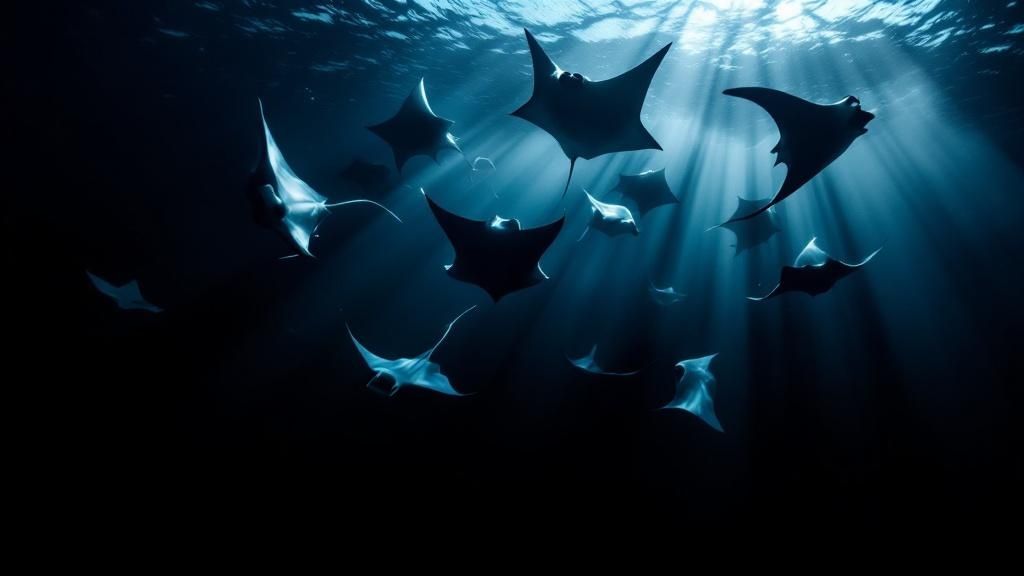
It’s totally normal to have some questions before jumping into the water at night, even with all the excitement building. We get it. Feeling confident and prepared is key to having an amazing time, so we've put together answers to the questions we hear most often from our guests.
Our goal is simple: to make sure you feel completely comfortable and ready for one of the best nights of your life. These are straightforward answers based on thousands of successful trips.
Do I Need To Be A Strong Swimmer?
This is probably the most common question we hear, and the short answer is no, you don't need to be an Olympic swimmer. While you should be comfortable in the water, you'll be holding onto a big, stable, floating light board the whole time.
Think of it as your personal viewing platform. It provides all the support you need, so you can just relax, float, and enjoy the show happening right below you. We also provide wetsuits which add extra buoyancy (and warmth!), making this an incredible experience for just about everyone.
Is The Manta Ray Snorkel Safe?
Absolutely. Safety is our number one priority, and the mantas themselves are incredibly gentle. They're often called "gentle giants" for a reason—they are completely harmless to people.
Unlike their stingray cousins, manta rays don't have stingers, barbs, or even teeth. They're filter feeders, which means they're only interested in the microscopic plankton that are drawn to our lights. Our experienced in-water guides are with you every step of the way, providing a detailed briefing beforehand and staying with the group to make sure everyone is safe and having a blast.
What Happens If No Mantas Show Up?
Manta rays are wild animals, and while Kona has an incredible sighting success rate of over 90%, there's always that rare night when they decide to party elsewhere. It doesn't happen often, but if it does, you're covered.
Reputable tour companies have what's called a "manta guarantee." If you don't see a single manta on your trip, you can come back and try again another night for free (usually on a standby basis). Make sure you confirm this policy before you book!
This is a great reason to schedule your manta ray night snorkel Kona adventure early in your vacation. That way, you have plenty of time to take advantage of a second chance if you happen to hit that unlucky 10%. For a deeper dive on this and many other topics, check out our massive manta ray FAQs page.
Ready for an adventure you'll be talking about for years to come? Kona Snorkel Trips is Hawaii's top-rated and most-reviewed snorkel company, and we're passionate about creating safe, unforgettable encounters with Kona's majestic manta rays.
